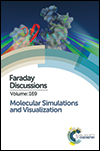Innovative interactive flexible docking method for multi-scale reconstruction elucidates dystrophin molecular assembly†
Abstract
At present, our molecular knowledge of dystrophin, the protein encoded by the DMD gene and mutated in myopathy patients, remains limited. To get around the absence of its atomic structure, we have developed an innovative interactive docking method based on the BioSpring software in combination with Small-angle X-ray Scattering (SAXS) data. BioSpring allows interactive handling of biological macromolecules thanks to an augmented Elastic Network Model (aENM) that combines the spring network with non-bonded terms between atoms or pseudo-atoms. This approach can be used for building molecular assemblies even on a desktop or a laptop computer thanks to code optimizations including parallel computing and GPU programming. By combining atomistic and coarse-grained models, the approach significantly simplifies the set-up of multi-scale scenarios. BioSpring is remarkably efficient for the preparation of numeric simulations or for the design of biomolecular models integrating qualitative experimental data restraints. The combination of this program and SAXS allowed us to propose the first high-resolution models of the filamentous central domain of dystrophin, covering repeats 11 to 17. Low-resolution interactive docking experiments driven by a potential grid enabled us to propose how dystrophin may associate with F-actin and nNOS. This information provides an insight into medically relevant discoveries to come.
- This article is part of the themed collection: Molecular Simulations and Visualization

 Please wait while we load your content...
Please wait while we load your content...